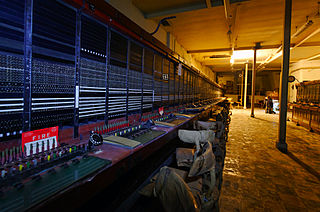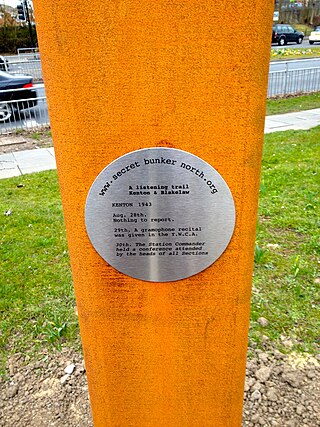
Continuity of government (COG) is the principle of establishing defined procedures that allow a government to continue its essential operations in case of a catastrophic event such as nuclear war.

ROTOR was an elaborate air defence radar system built by the British Government in the early 1950s to counter possible attack by Soviet bombers. To get it operational as quickly as possible, it was initially made up primarily of WWII-era systems, notably the original Chain Home radars for the early warning role, and the AMES Type 7 for plotting and interception control. Data from these stations was sent to a network of control stations, mostly built underground, using an extensive telephone and telex network.

Remote Radar Head Neatishead, and commonly abbreviated RRH Neatishead, is an air defence radar site operated by the Royal Air Force (RAF). It is located approximately 11 kilometres north-east of Norwich in the county of Norfolk, England.

RAF Daws Hill was a Ministry of Defence site, located near High Wycombe and Flackwell Heath, in Buckinghamshire, England, close to the M40 motorway.

Barnton is a suburb of Edinburgh, Scotland, in the north-west of the city, between Cramond and Corstorphine Hill and west of Davidsons Mains. Part of the area was traditionally known as "Cramond Muir" in reference to Cramond to the north.
The Corsham Computer Centre (CCC) is an underground British Ministry of Defence (MoD) installation in Corsham, Wiltshire, built in the 1980s. According to the MoD, the centre "processes data in support of the Royal Navy". The centre has been similarly described by Des Browne in 2007, then Secretary of State for Defence, as a "data processing facility in support of Royal Navy operations".

The Central Government War Headquarters (CGWHQ) is a 35-acre (14 ha) complex built 120 feet (37 m) underground as the United Kingdom's emergency government war headquarters – the hub of the country's alternative seat of power outside London during a nuclear war or conflict with the Soviet Union. It is located in Corsham, Wiltshire, in a former Bath stone quarry known as Spring Quarry, under the present-day MoD Corsham. In 1940, during the Second World War, the site was acquired by the Minister of Aircraft Production and used as an underground engine factory.

The Hack Green Secret Nuclear Bunker is a former government-owned nuclear bunker located at Hack Green, Cheshire, England.

Corstorphine Hill is a low ridge-shaped hill rising above the western suburbs of Edinburgh, Scotland. Although there has been residential and commercial development on its lower slopes, especially in the south and west, most of the hill is occupied by a local nature reserve, consisting of extensive broadleaf woodland, accessible to the public.

RAF Rudloe Manor, formerly RAF Box, was a Royal Air Force station located north-east of Bath, England, between the settlements of Box and Corsham, in Wiltshire. It was one of several military installations situated in the area and covered three dispersed sites. The sites are now used by Defence Digital.
Regional seats of government or RSGs were the best known aspect of Britain's civil defence preparations against nuclear war. In fact, however, naming conventions changed over the years as strategies in Whitehall changed.
The British Telecom microwave network was a network of point-to-point microwave radio links in the United Kingdom, operated at first by the General Post Office, and subsequently by its successor BT plc. From the late 1950s to the 1980s it provided a large part of BT's trunk communications capacity, and carried telephone, television and radar signals and digital data, both civil and military. Its use of line-of-sight microwave transmission was particularly important during the Cold War for its resilience against nuclear attack. It was rendered obsolete, at least for normal civilian purposes, by the installation of a national optical fibre communication network with considerably higher reliability and vastly greater capacity.

The Kelvedon Hatch Secret Nuclear Bunker at Kelvedon Hatch, in the Borough of Brentwood in the English county of Essex, is a large underground bunker maintained during the Cold War as a potential regional government headquarters. Since being decommissioned in 1992, the bunker has been open to the public as a tourist attraction, with a museum focusing on its Cold War history.

Chilmark is a Wiltshire village and civil parish of some 150 houses straddling the B3089 road, 11 miles (18 km) west of Salisbury, England. The parish includes the hamlets of Mooray and Portash, both close to the south of Chilmark village; and the dispersed hamlet of Ridge, to the southwest.
RAF Sopley was a World War II station, codenamed Starlight, near the village of Sopley in Hampshire. The Radar Station was opened in December 1940. In 1959 it became an air traffic control radar station, and finally closed on 27 September 1974. Nearby Sopley Camp was built in the early 1950s as a domestic site for the radar station and is probably best known as the initial home of the Vietnamese Boat People, in 1979. The camp was sold in 1993 to a local partnership under the name Merryfield Park. Most of the old barracks site had been redeveloped as housing, but the 2-storey building at the Sopley end has been converted into a museum/education centre by Friends Of New Forest Airfields (FONFA). The museum opened in May 2016.

Royal Air Force Holmpton or more simply RAF Holmpton is a former Royal Air Force Cold War era nuclear bunker that was built in the 1950s as an early warning radar station as part of the ROTOR Radar Defence Programme. Located just south of the village of Holmpton, in the East Riding of Yorkshire, England, RAF Holmpton remained a part of the Defence Estate right up to 8 December 2014 when it was sold into private ownership after 62 years of military service.

Royal Air Force Pitreavie Castle or RAF Pitreavie Castle was a station of the Royal Air Force located at Pitreavie Castle in Dunfermline and near Rosyth, Fife, Scotland.

RAF Blakelaw was a Royal Air Force station which acted as headquarters for No.13 Group during the Second World War and which was located in Blakelaw, Northumberland.

Raigmore House was a country house in Raigmore, Inverness.

Royal Air Force Shipton was a First World War era airfield located north of the village of Shipton-by-Beningbrough, in North Yorkshire, England. During the First World War, it was used by No. 76 Squadron RAF whose remit was to provide Home Defence (HD).
















